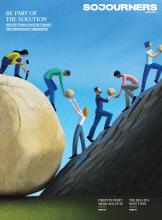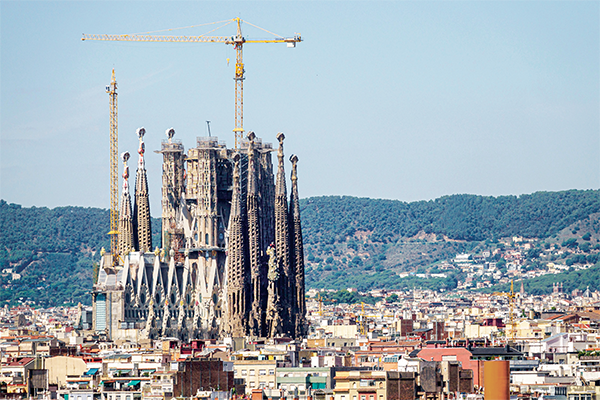WHEN ANTONI GAUDÍ became the chief architect for Barcelona’s Sagrada Família Basilica in fall 1883, he had no illusions that he would live to see its completion. “There is no reason to regret that I cannot finish the church,” he said. “I will grow old, but others will come after me. What must always be conserved is the spirit of the work, but its life has to depend on the generations it is handed down to.”
After 142 years of construction, Gaudí’s masterpiece is slated to be finally completed in 2026, 100 years after Gaudí’s death. The finished basilica will have three distinct facades, only one of which was completed in Gaudí’s lifetime, and 18 towers — 12 for the apostles, four for the evangelists, one for the Virgin Mary, and the tallest and most central tower for Jesus. When you look at the Barcelona skyline from Park Güell, where the architect lived for almost 20 years, the basilica soars above the rest of the city, clothed in scaffolding. From far away, the cone-shaped, sand-colored spires look like intricate, naturally occurring stalagmites, reaching toward the heavens.
Gaudí’s iconic style — lots of curves, a heavy use of mosaic, and motifs from nature and Catalonia — was an extension of the broader artistic movement of Modernisme, the Catalonian cousin of Art Nouveau. Even though some of the visual language of the Sagrada Família had precedent in buildings such as the Castell dels Tres Dragons or the Palau de la Música Catalana, both by Lluís Domènech i Montaner, the basilica was still controversial. George Orwell once said that the Sagrada Família was “one of the most hideous buildings in the world,” and lamented that it hadn’t been destroyed during the Spanish Civil War. But more than a century later, Gaudí is widely recognized as an artistic genius, and his works have UNESCO World Heritage site status.
There are no exact right angles in the Sagrada Família’s design because Gaudí believed right angles didn’t occur in nature. Instead, you will find the spiral of a shell, the honeycomb structure of a beehive, the branches of a tree, and the unique curvature of a leaf. He also pioneered the mosaic technique known as trencadís, where pieces of ceramic or glass were broken into irregular shapes and applied to the surface of a form.
Read the Full Article

